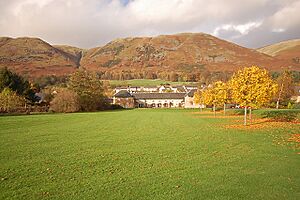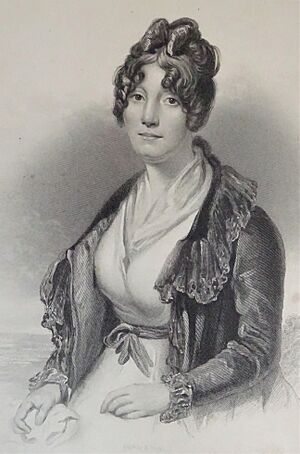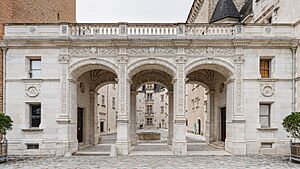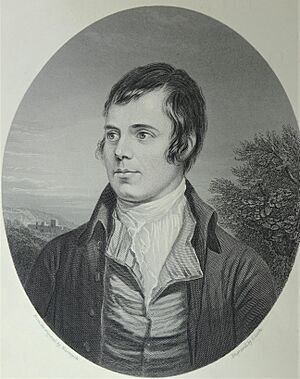Margaret Chalmers (Mrs Lewis Hay) facts for kids
Quick facts for kids
Margaret Chalmers
|
|
|---|---|
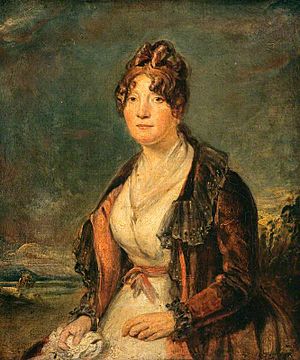
Margaret Chalmers
|
|
| Born | 1763 Fingland, Kircudrightshire
|
| Died | 3 March 1843 Pau, France
|
| Occupation | Wife, Musician and vocalist |
Margaret Chalmers (1763–1843) was a close friend of the famous Scottish poet Robert Burns. She was also known as Mrs Lewis Hay after she married Lewis Hay. Margaret and Robert Burns wrote letters to each other for several years. She even turned down his offer of marriage, but they remained good friends.
After her husband Lewis died in 1800, Margaret moved to Pau in France. She lived there until she passed away in 1843.
Contents
Early Life and Family
Margaret, often called Peggy, was born in 1763. She was the youngest daughter of James Chalmers. Her family lived on the Fingland Estate in Kircudbrightshire, which is now part of Dumfries and Galloway.
Sadly, her father faced money problems. He had to sell their estate. The family then rented Braehead Farm in East Ayrshire. This farm was close to Mauchline, where Robert Burns lived at Mossgiel Farm. This is likely where Margaret and Robert Burns first met.
Margaret was very smart and loved to learn. She taught herself a lot about books and music. She was also a talented singer of traditional Scottish songs. Her mother, Euphemia Chalmers, also knew Robert Burns. They met at the Harvieston Estate during one of Burns's trips.
Marriage and Later Years
Margaret Chalmers married Lewis Hay on December 9, 1788. Their engagement was a secret from her family for a while. Lewis worked as a banker at a company in Edinburgh.
The couple lived in Edinburgh and later moved to the continent. They had six children together, three sons and three daughters. Lewis Hay passed away in 1800.
Around 1820, Margaret moved to Pau in southern France. She lived there for many years. Margaret died in Pau on March 3, 1843, when she was 80 years old.
Friendship with Robert Burns
Robert Burns was very fond of Margaret and her close friend and cousin, Charlotte Hamilton. He often wrote about them together in his letters. In November 1787, he told Margaret that she and Charlotte were like peaceful places for his soul. He said they were a comfort in the "weary, thorny wilderness of this world."
After a trip through the Highlands, Burns spent eight days with Margaret at the Harviestoun Estate in October 1787. This estate was near Dollar. Margaret was related to Burns's good friend, Gavin Hamilton. A special stone monument has been built at Harviestoun Castle to remember Burns's visit.
Burns also met Margaret again at the home of Dr. Thomas Blacklock in Edinburgh. Margaret often played the piano and sang for Dr. Blacklock, who was blind.
Margaret later shared with poet Thomas Campbell that Burns had asked her to marry him. However, she politely said no because she was already secretly engaged to Lewis Hay. Despite this, they managed to stay good friends.
Burns sometimes used French phrases in his letters to Margaret. Once, Margaret playfully introduced Burns to a French lady. Burns tried to speak French with her, but they couldn't understand each other. This was a bit embarrassing for the poet! After this, Burns decided to take French lessons.
Just nine days before he died, Burns sent a song called "Fairest Maid on Devon Banks" to a friend. Some people think he wrote this song for Margaret. However, it's more likely he wrote it for her cousin, Charlotte Hamilton.
Margaret was one of only two younger women with whom Burns had a deep, intellectual friendship. The other was Maria Riddell. Burns's continued affection for Margaret is clear. In a letter from January 1788, he said he kept a female friend "in my heart's core by Peggy Chalmers."
Here are some lines from "Fairest Maid on Devon Banks":
|
Fairest Maid on Devon banks, Full well thou knowest I love thee dear, |
Burns also mentioned Margaret in two of his love songs. One was "Where Braving Angry Winter's Storms". The other was "My Peggy's Face, My Peggy's Form". This song was later published with 'Mary' instead of 'Peggy'.
Here are some lines from "My Peggy's Face, My Peggy's Form":
|
"My Peggy's face, my Peggy's form, |
Burns wrote to Margaret around December 1787 to calm her worries. He told her that his poetic compliments were not meant to reveal her identity to everyone. He said he praised her mostly for her inner beauty and intelligence. He also told her to stop being so shy!
Margaret's friend, Miss Nimmo, hosted a tea party. It was there that Burns first met Agnes Maclehose, another important woman in his life.
After Burns died, Margaret's husband, Lewis Hay, helped raise money for Burns's wife, Jean, and her family. This was very kind, as there wasn't a clear rule for banks to do this at the time.
Letters from Burns
Robert Burns wrote many letters to Margaret Chalmers. Some of these letters are not dated, so their exact timing can be a bit confusing. Sadly, none of the letters Margaret wrote to Burns have survived.
In one letter from January 1787, Burns wrote to Margaret. He joked that her piano playing had somehow affected his heart. He said he felt a strange feeling when she looked kindly at someone else.
In October 1787, Burns wrote that he wanted to write a poem for Charlotte. He asked Margaret to help him find a good old Scottish tune for it.
On November 21, 1787, Burns encouraged Margaret to write whatever came to her mind. He told her to write about what she saw, read, or heard. He even said she could write "trifles, bagatelles, nonsense."
From Edinburgh on December 12, 1787, Burns wrote to Margaret. He told her he was recovering from a leg injury. He also mentioned that he was reading the Bible. He sent her a copy of his song "Banks of the Devon" for Charlotte.
On January 22, 1788, Burns wrote to Margaret about problems with his publisher. He said his publisher had promised him an account but hadn't delivered. Burns added that his leg was getting better.
On March 14, 1788, Burns told Margaret he had bought a farm called Ellisland. It was near Dumfries. He planned to build a house there and start farming. He also shared his plans to join the Excise Service, which collected taxes.
In his last known letter to Margaret, on September 16, 1788, Burns wrote from his new farm. He told her that he was stuck inside due to bad weather. He said he had never met two people whose friendship meant so much to him. He felt he had lived more of a "real life" with her in eight days than with others in eight years. He also mentioned how unlikely it was they would meet again.
Burns also shared that his wife, Jean, didn't read much. However, she had read his book of Scottish poems very carefully.
Many of Margaret's letters to Burns were lost. It's said that Gavin Hamilton's sister, Charlotte Hamilton, threw them into a fire.
In a letter from October 15, 1790, Burns asked a friend to remember him to Mrs. Lewis Hay (Margaret). He admitted he felt bad for not writing to her more often.
Margaret is known to have written to Burns twice between 1788 and 1792. One of these letters was an invitation for him to visit her. It's not known if Burns ever met Margaret after she got married in 1788.
Images for kids


